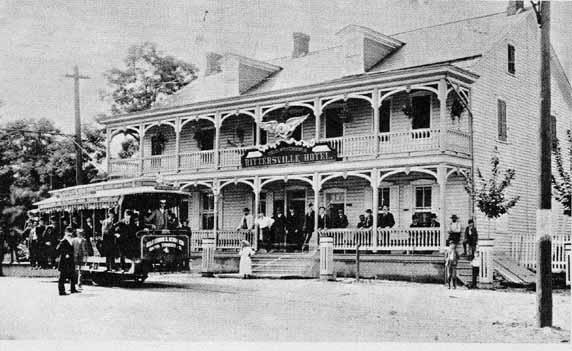
Historically, two things were needed to make a village: a crossroads, and a tavern and inn. The crossroads provided the traffic, while the tavern and inn provided a meeting place for local residents and a place for travelers to stay overnight during the arduous journey from one place to another. Most often, the name of the village was based upon the name of the proprietor of the tavern. Rittersville was no exception.
Although he was not the first resident in the Rittersville area (see Early Rittersville Settlers), the village "founder" is considered to be Michael Ritter. In 1808, Ritter and his family moved from Northampton county to Rittersville where their second child, Thomas Ritter, was born in 1808. (see John Michael Ritter)
A tavern had been kept in Rittersville for some years before Ritter moved to the area. It was located at the junction of today's Hanover and Eaton Avenues. It was at this point that the King's Road, which was built in 1756 and linked Easton to Reading, passed through the area that was to become Rittersville.
In 1808, Ritter bought the tavern, which was built of logs, and managed it until 1832, at which time his son, Charles, took over and managed it until 1865. It was maintained in succeeding years by J Frank Reichert (1869-1883), followed by E. W. Gangawere. This tavern became the site of the Rittersville Hotel and subsequently, the Manhattan Hotel. (see The Rittersville Hotel)

After the building of the first bridge across the Lehigh river to Allentown in 1812, a road was established between the bridge and Bethlehem. Prior to that time the main road from Bethlehem to Allentown was known as The King's Road, which was surveyed in 1755 and ran from Easton to Reading.
The road laid out by the county in 1812 from the Lehigh River bridge to Rittersville is the Hanover Ave of today. (Prior to the bridge being built, travelers forded the river at what is now Klines Island, just south of the present-day Hamilton St bridge.) In Bethlehem, this road followed W Broad St to the junction with West Market St, and followed W Market a short distance at which it turned onto Prospect Ave, which ran to the Monocacy Creek. At one time, W Market St and Prospect Ave. were known as the Allentown Road. This road, which ran through the heart of Rittersville, connected Easton, Bethlehem, Allentown and Reading, as well as connecting with roads to Philadelphia, and made the village a way station for many travelers.
In 1812, the first school was built in Rittersville. The building of the school was initiated by Michael Ritter. School was taught in the German language and was held there irregularly until 1834, when Hanover Township accepted the new school law. At that time, a new school house was built, and around 1850, a new 2-story brick schoolhouse was erected across the street from St Peter's Union Church, on what is now Tacoma St.
Besides the tavern, one of the earliest businesses in Rittersville began in 1822, when Jacob Alshouse opened his blacksmith shop. This business was carried on for almost 80 years under various owners until it was discontinued in the early 1900's by John Roller, who took over the business around 1884.
In 1825, there was enough traffic coming through the area to cause Michael Ritter to open a store at the same site as the tavern. Ritter managed the store for a number of years, after which it was kept, respectively, by David Knauss, Henry Moyer, Milton Ritter, and Edwin Osenbach, who was managing it in 1884.
On March 8, 1828, Rittersville officially opened it's own post office. Michael Ritter was appointed the first postmaster. His son, Charles, took over as postmaster in 1832, and held that office until he died in 1883, at which time, Edwin Osenbach was appointed.
Another school, the Bast School, was built in the Rittersville area in 1838 It was a 1-1/2 story building that was located at what is now the north side of Hanover across from Jerome St. And another business opened in Rittersville in the 1840's when Jesse Acker, a shoemaker, moved to Rittersville with his family.
During this period of early settlement, Rittersville residents who wanted to attend church had to travel to Schoenersville to attend services at Christ Church. (Schoenersville was settled about 1779, and Christ Church was built in 1781.) By 1842, there were sufficient residents in Rittersville to justify the building of their own church. A committee was formed and land was procured from Thomas Ritter for $30. The cornerstone of St Peter's Union Church was laid in 1842 at the site of the church today on Tacoma St. and the dedication of the church was on August 28th and 29th, 1842. In 1899, the church was remodeled with an 'L" addition added to the south side.
|
|
|
|
The Original St Peter's Union Church |
St Peter's Union Church After 1899 Remodeling |
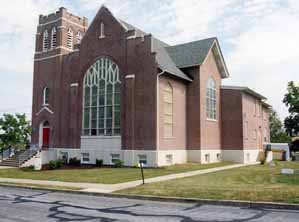
The Church Today
Horse racing was popular in the area and in 1868, J Frank Reichert laid out a race course on the north side of Hanover Ave, just west of the Rittersville hotel. In 1872, the Rittersville Park Association was formed and enlarged the site to 16 acres at a cost of $12,000. The Rittersville races were news. Articles from the Allentown and New York newspapers are shown below.
In the 1880's and 1890's, the track was used for bicycle racing, as well, and in at least one case was the site of a foot race. This land eventually passed to the Lehigh Valley Traction Company.
Allentown Newspaper, September 5, 1877 |
Program from Rittersville Racetrack, Oct. 1883 |
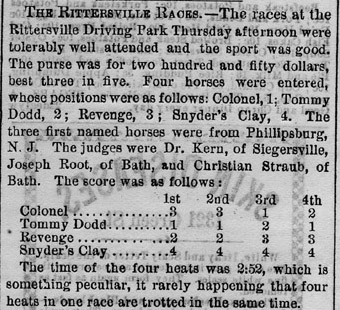 |
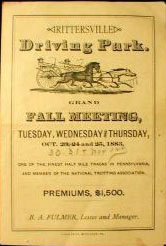 |
New York Daily Herald, Oct. 15, 1879 |
New York Daily Herald, Oct. 18, 1879 |
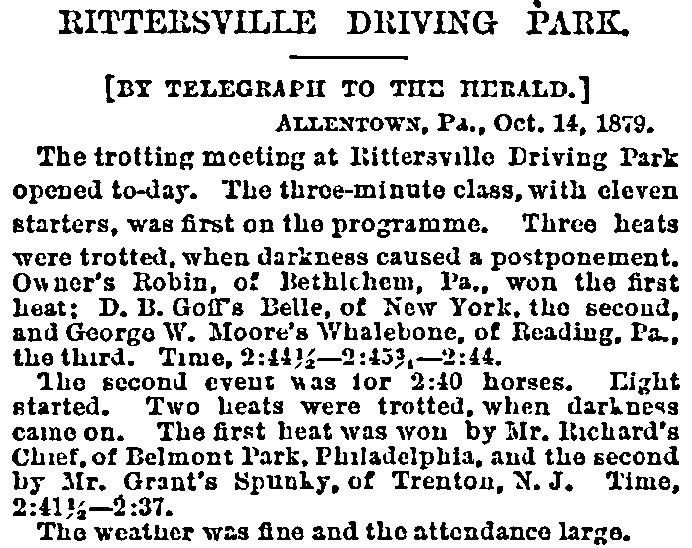 |
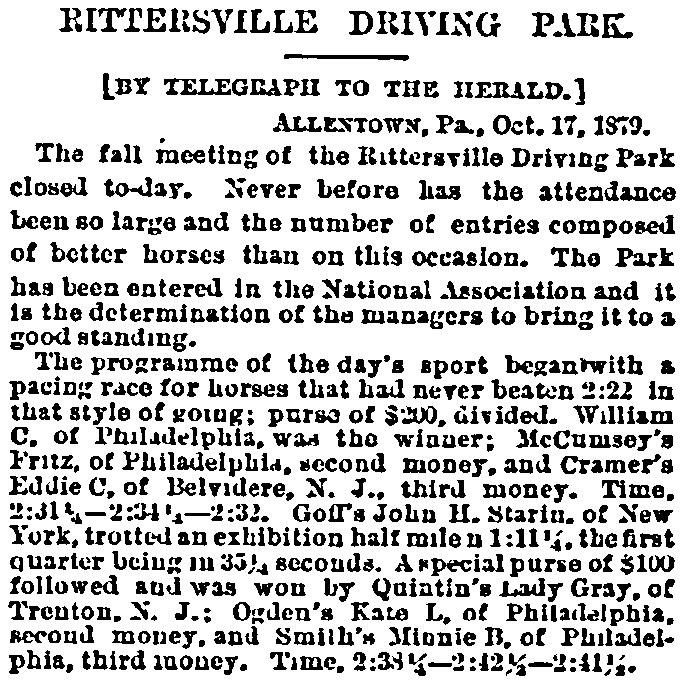 |
Philadelphia Inquirer, Aug. 16, 1896
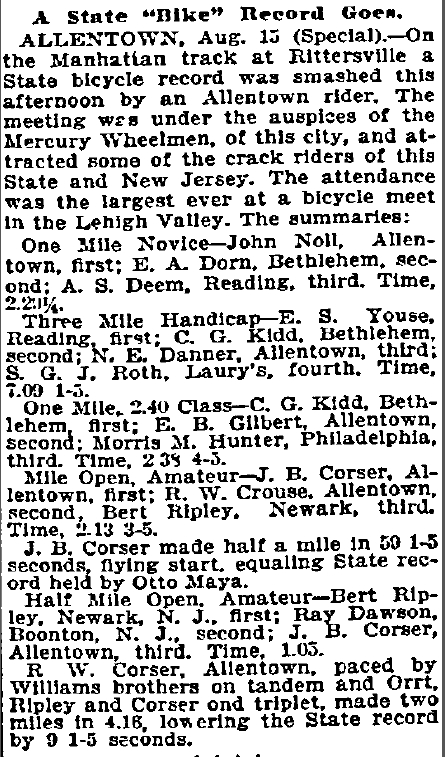
Trenton Times, June 28, 1884
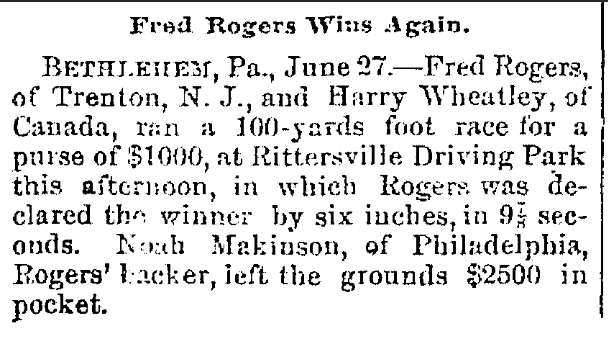
Horse racing and bicycle racing weren't the only sports to be found in Rittersville. Baseball was also big. In 1894, when Albert Johnson, president of the Lehigh Valley Transit Co., established the Manhattan Park baseball field in Rittersville, he brought in the famous Michael "King" Kelly, star player for Cincinnati, Chicago and Boston, as a player/manager for the Allentown team. The Manhattan Park baseball field was a popular venue for baseball for many years.
| Philadelphia Inquirer, April 28, 1891 | Wilkes-Barre Times, Oct. 31, 1894 |
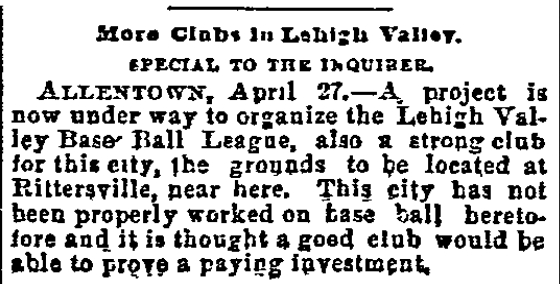 |
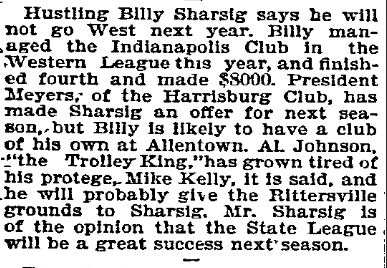 |
Philadelphia Inquirer, March 21, 1896 |
Philadelphia Inquirer, March 22, 1896 |
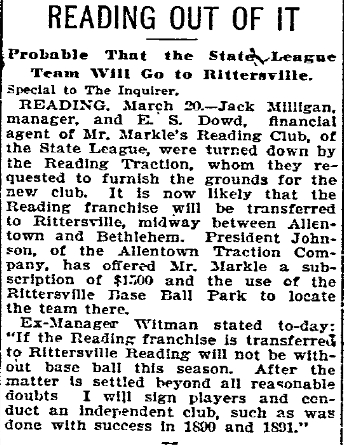 |
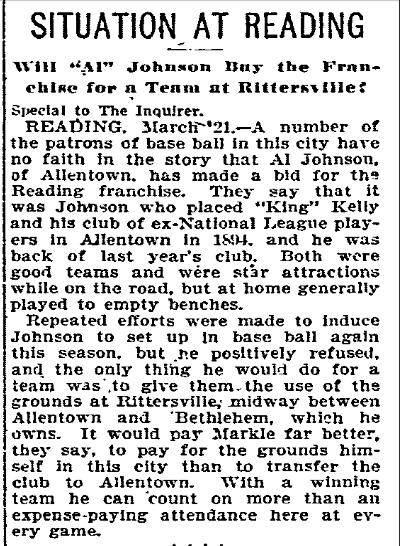 |
|
The
Wilkes-Barre Times, Wilkes-Barre, Pa., November 16, 1894 TO KING KELLY’S
MEMORY -- A Unique Memorial at the Manhattan Hotel, Rittersville From the walls of the Manhattan Hotel, Rittersville, where the late King Kelly played ball last season, a unique memorial is suspended. In the centre is a neatly framed picture of the king, over which are two crossed base ball bats that were used by the dead ball player. At the point where the bats cross there is a base ball that has apparently seen good service. The ball has a history, as it enacted an important part in one of the greatest tricks ever seen on a base ball field here.
It was during one of
those exciting Allentown – Harrisburg games.
Allentown was ahead but the score was close.
Harrisburg had a man on base and no one out.
One of the visiting team hit to Sweeny at short, who threw the
ball over the head of Kelly, and it went under the bleachers.
Both Kelly and Donoghue started for the ball and while the latter
was vainly trying to get it, Kelly, who saw a Harrisburg man starting
from third to home, made a big bluff.
He ran towards the home plate, pretending he had the ball and any
time the runner took a step toward home Kelly made a feint to throw.
Although Kelly’s hands were empty he held the runner on third
until the lost ball was secured and thrown home, to the delight of the
crowd. The trick saved
Allentown the game. From the
lower side of Kelly’s picture his leather bat bag is suspended and the
whole is appropriately decorated in embers of mourning. |
In 1869, a petition was made to form a turnpike company to improve the road that led from the Lehigh River bridge to Bethlehem. The Allentown-Bethlehem Turnpike and Plank Road company was formed and an attempt was made to sell stock in the company to finance the project. However, this early attempt failed.
In 1871, the Broad St bridge in Bethlehem was opened across the Monocacy creek, thus creating a route directly into the downtown portion of Bethlehem and allowing easier access to West Bethlehem from Bethlehem. This stimulated considerable building in the West Bethlehem area, which also included parts of Rittersville at that time.
(The following year, 1872, an event occurred that, although unknown to the residents of Rittersville, would have lasting consequences for the village. That event was the birth of Robert J Klotz, in Guthsville, Pa.)
In Daniel Rupp's 1845 history of Lehigh County, he describes Rittersville as "A post village [i.e., a village that had its own post office] consisting of five dwellings, one tavern, one store---a church, near it, is located in the poor part of the township." It's hard to believe that there were so few inhabitants of Rittersville at that early date. Perhaps Rupp didn't know Rittersville's boundaries. Perhaps Rupp didn't consider the many farms in the area. Whatever the circumstances, over the next 30 years, the village grew exponentially. By 1874, there were more than 70 dwellings in the village. (See 1874 Map of Rittersville - note how most of the homes are clustered along the turnpike and what is now Eaton Ave. and W. Broad St.) A directory of Lehigh County from 1877 lists the names of 67 male residents of Rittersville. (see List of Male Inhabitants - 1877 & 1895)
In 1876, another attempt was made to build a turnpike from the Lehigh River bridge to Bethlehem, and the Allentown & Bethlehem Turnpike Company was chartered. It was authorized capital of $15,000 with shares of stock selling for $10 each. The original subscription was sold out and the company began to build the road during Summer and Fall of 1876. The road, which followed Hanover Ave., was a toll road with three toll gates: one at the junction of East Hamilton St and Hanover Ave., one at Rittersville located near the intersection of W Broad St and Pennsylvania Ave., and one at the Broad St bridge.
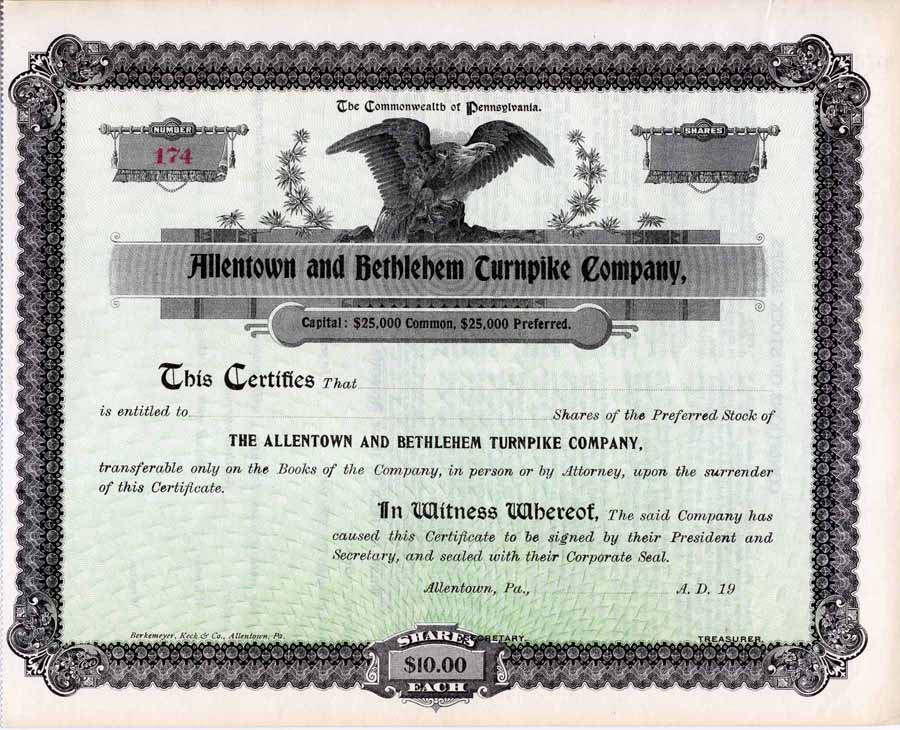
In 1886, West Bethlehem was incorporated into Bethlehem. The western boundary of West Bethlehem was 5th Ave. Much of the unincorporated portion west of 5th Ave. was still considered part of Rittersville.
The early 1890's saw some major changes that would shape Rittersville for years to come. Up until 1891, trolley service never reached Rittersville or Bethlehem. The early horse-drawn trolleys operated by the Allentown Passenger Railway Co., crossed the Hamilton St bridge and stopped in East Allentown south of the bridge at what was the location of the Lehigh & Susquehanna Railroad passenger terminal. Even this service was discontinued in 1890.
In 1891, the Allentown & Bethlehem Rapid Transit Company, the successor to the Allentown Railway Passenger Co., started electric trolley service in Allentown along Hamilton St on July 1, 1891. The line reached Rittersville on July 5, 1891, and Bethlehem at Broad and New Sts. on August 2, 1891. The fare was 5¢ from Allentown to Rittersville, and 5¢ from Rittersville to Bethlehem.
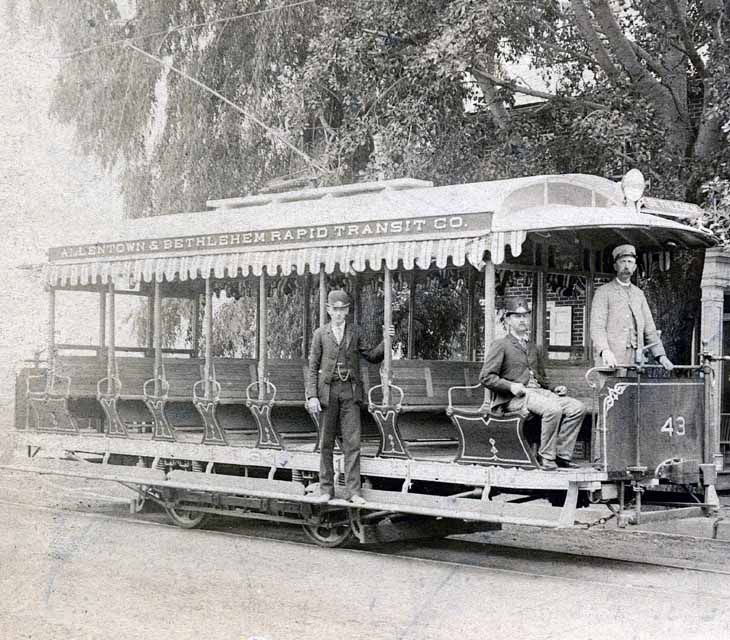 |
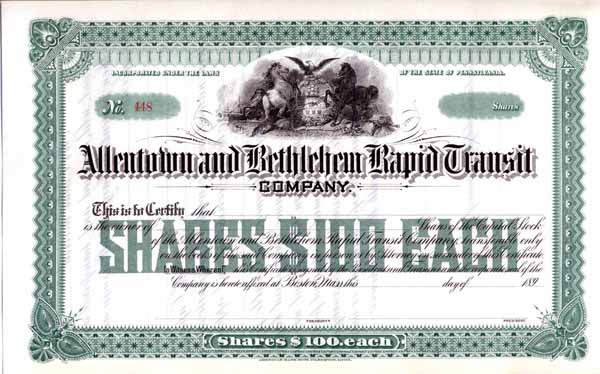 |
Electric Trolley - Allentown Bethlehem Rapid Transit |
1890's Stock Certificate - Allentown Bethlehem Rapid Transit Co. |
In 1892, the company constructed a carbarn at Rittersville, and in the summer of 1893, the company established a menagerie, merry-go-round, and picnic grounds along the south side of Hanover Ave, across from the Rittersville Hotel.. The spot was called Central Park, and throughout the early 20th century, the name Central Park became associated with the village of Rittersville. (See Central Park) After Central Park was established, the carbarn also became a place to keep the menagerie animals over the winter. In 1896, a year before the Rittersville Hotel burned, this structure was also the victim of a massive fire.
|
The Allentown
Morning Call, Allentown, Pa., April 19, 1896 THE WINTER
GARDEN IS IN ASHES --- The Big Frame
Structure at Rittersville a Mass of Ruins --- STRUCK BY LIGHTNING
---Last Evening Shortly Before Nine O’clock --- AID CAME FROM ALLENTOWN Shortly before 9
o’clock last evening, during the progress of the storm, the winter
garden building at Rittersville, owned by the Lehigh Valley Traction
Company, was struck by lightning.
The building was completely destroyed.
To-day nothing stands but a few charred pillars of the building
which, during the winters of ’94 and ’95, was visited by thousands of
people. The bolt struck the
building on the roof near the main entrance, setting on fire the
rafters, which soon communicated the flames to a quantity of hay, which
was stored in an apartment near the elephant stalls. The smoke was
discovered by people who were passing.
They ran to the hotel and informed employees of the road.
A small hose was attached to a hydrant and run up to the
building. When the door was
opened it was evident that this small amount of water could not cope
with the fire, as a large part of the wood work and a section of the
roof were by this time burning briskly.
The officials at the
office at Sixth and Hamilton streets, this city, were notified and the
consent of Mayor Lewis was at once acquired to allow an engine and hose
carriage of the Allentown Fire Department to be taken to the scene of
the fire. The Allen steamer
and hose were hastily dispatched.
The engine was secured to an electric car on the east entrance to
the river bridge and taken to the fire.
By this time, however, the building was a mass of flames. |
The small boiler room
in the rear of the structure had also caught fire and was past saving.
The heat caused by the flames and the iron sides of the building,
which at this time were heated to a bright red, was intense.
The sky was brilliantly lighted up causing a glow that could be
seen for many miles around.
The road did a rushing
business. Every electric car
was jammed and the drive way from the hotel to the burning building was
covered with people.
About 10 o’clock the
front of the building tottered over and fell with a crash sending
millions of sparks into the air.
The firemen were in readiness to quench any flame that might
appear on any of the surrounding buildings.
For a time the grandstand was in danger and the board fence
between the buildings was torn down.
At 11 o’clock nearly all of the ruins had fallen and a stream of
water was played on the rear to prevent sparks from arising. The building was
erected about six years ago and up to the winter of 1894 was used as a
repair shop and storage building for the cars.
It was fitted up with cages and stalls for the animals, which
occupied the front part of the building.
The rear was used as a concert hall and was supplied with a
raised stage and seats. A
costly heating apparatus was also added.
The dimensions of the structure were 250 feet long by 106 feet
wide. The loss is placed at
$10,000, which is fully covered by insurance.
The elephant “Duchess”, which will arrive in a few days with a
lot of other animals, was to have her headquarters in the building.
The company was negotiating with a manager of a variety troupe to
use the place for giving concerts during the summer which will now be
cancelled, as it is not definitely settled whether the company will
rebuild. |
Also during this period, the traction company built a horse-racing track west of the Rittersville Hotel on the north side of Hanover Ave. (This was probably the location of the Rittersville Park Association's original site.) When interest in racing waned, around the early 1890's, the trolley company converted the tract into a baseball diamond, and later, after WWI, converted the area into a parking lot.
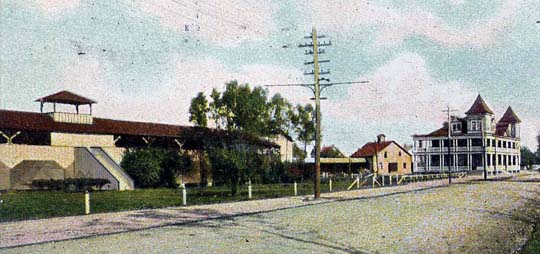
During this period, Rittersville also grew as more businesses moved into the area. In 1892, John Horn established his floral business on the west side of what is now Sherman St., north of Hanover Ave. It consisted of 16 greenhouses on 15 acres. His showroom was in Allentown.
In 1893, Cyrus Lapp established a carriage works along what was to become Broad St in West Bethlehem, and the Hanover Hotel was established by Henry J Moyer on Broad St just east of Central Park. This establishment existed for many decades into the 1950's. The site is now occupied by a used car lot.
In 1894, Dr. Robert J Klotz moved to Rittersville and is considered to be the village's first physician.
(As an interesting sidelight, a Lehigh County directory from 1895 lists a C. Bartholomew as a physician in Rittersville. Being curious, I checked an 1890 City of Allentown directory and found Cornelius Bartholomew, physician, with an office on N. Fifth St. I then checked the 1880 US census but could find no record of the guy. A 1870 census check lists the only Cornelius Bartholomew (who happens to have the same birth year as the so-called physician) as a 23 year-old laborer living in Moore Township. I then checked the 1900 census and found Mr. Bartholomew a prisoner in the Lehigh County jail! For impersonating a physician, I wonder?)
By 1895, Rittersville had a veterinarian, too. Dr Thomas W Moyer was a veterinarian and surgeon. He apparently created his own tonics which he labeled and sold.
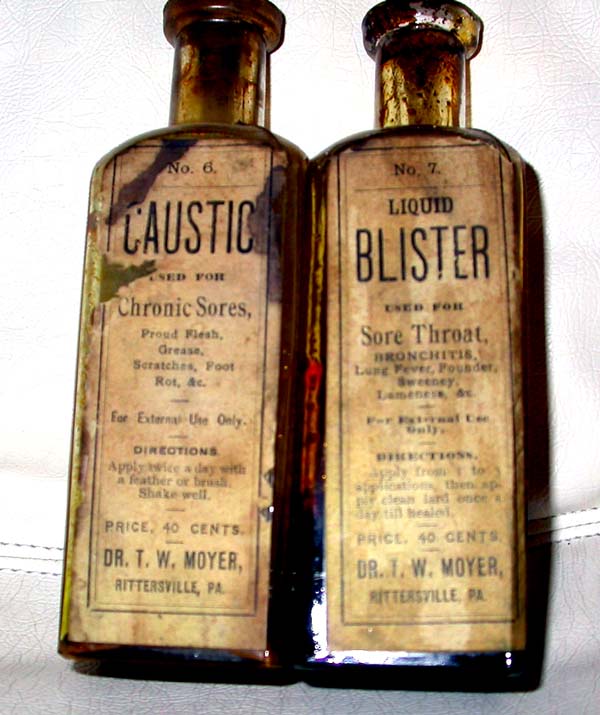
Although Rittersville was a small village, it was not untouched by the epidemics of infectious diseases that periodically swept the country.
| New York Times, Jan. 12, 1888 | New York Times, Sept. 9, 1888 |
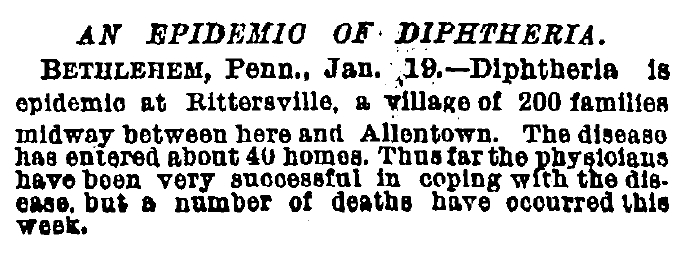 |
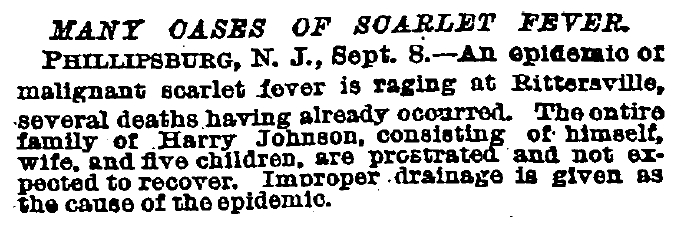 |
In 1895, a diphtheria epidemic hit East Allentown and Rittersville. In those days, epidemics could wipe out whole families. In a 60 day period, the Scherer family lost five members: four children and the mother. Others followed:
| Mabel Nancy Haney
Saturday, March 30, 1895 Death Notice Haney, In East Allentown, March 29th, 1895, of diptheritic croup. Mabel Nancy, daughter of Frank P> And Margaret Haney, aged 4 years and 27 days. Funeral services at the parents residence, 2:15 p.m. Relatives and friends are respectfully invited without further notice. Interment, West End Cemetery. |
| Minnie Rebecca Haney
Saturday, February 16, 1895 Death Notice Haney, in East Allentown, February 14, 1895, of diphtheritic croup, Minnie Rebecca, daughter of James and Mary Haney, aged 6 years, 1 month and 2 days. Funeral services at the residence of the parents, Walnut Street East Allentown on Sunday, afternoon at 2 o'clock. Interment at Rittersville Cemetery. |
| Charles W. F. Harris
Monday, March 4, 1895 Death Notice In Rittersville, March 1, 1895, Charles W. F., son of Frank E. and the late Emma E. Harris, aged 2 years, 3 months and 11 days. Funeral on Tuesday afternoon at 1:30 o'clock at the residence of the father, to which relatives and friends are cordially invited without further notice. Services and interment at Jerusalem Church in Salisbury |
| Raymond Henry Hausman
Monday, September 30, 1895 Death Notice Hausman, At Rittersville, Septembr 28, Raymond Henry, son of Harvey and Emma Hausman, aged 3 years, 11 months and 28 days. Funeral on Tuesday afternoon at 2 o'clock from the residence of the parents, Rittersville, to which the relatives and friends are respectfully invited without further notice. Services and burial at the Rittersville Church. |
| Catharine Scherer
Wednesday, March 27, 1895 Obituary Mrs. Catharine Scherer, wife of Moses Scherer, of East Allentown, died yesterday morning aged 27 years. Mr. Scherer has been sadly afflicted. A few weeks ago three children died within 4 days of each other. The first died February 16, 1895, aged 7 years, the second died Febuary 18, aged 5 years and 6 months and the third, February 20, aged 3 years. Her husband, an infant 9 days old survive. |
| Elizabeth May Sherer
April 26, 1895 Death Notice Sherer, In East Allentown, April 25, 1895, Elizabeth May, daughter of Moses and the late Catharine J. Sherer, aged 1 month and 7 days. Funeral services at the residence of the grandmother, near St. Joseph's Church, East Allentown on Saturday at 2 o'clock, p.m. Interment at Rittersville Cemetery |
| Child Stine
Monday, March 25, 1895 Obituary The child of Irvin Stine, of near Rittersville, aged 5 years, died on Saturday. Funeral on Tuesday afternoon at the Schoenersville Church. Rev. A. B. Horne will officiate. |
| Templeton J. Flores
Monday, April 1, 1895 Death Notice Flores, at Rittersville, March 29, 1895, Templeton, J., son of James and Mary Flores, aged 18 years, 3 months and 2 days. Funeral on Monday at two o'clock from the residence of the parents in Rittersville, to which the relatives and friends are invited without further notice. Services and burial at Rittersville Church |
| Irvin F. Deily
Monday, February 25, 1895 Death Notice In East Allentown, on February 23, 1895, Irvin F., son of George E. and his wife, Maggie Deily, aged 1 year, 5 months and 23 days. Death was caused by Diphtheritic croup Funeral on Monday afternoon at 2 p.m. from the residence of the parents in East Allentown. Friends and relatives are respectfully invited to attend. Services will be held at the parents residence. Burial at Rittersville Cemetery. |
| Elsie M. Ginginger
Wednesday, November 20, 1895 Death Notice Ginginger, In South Allentown, November 18, 1895, Elsie M., a daughter of Samuel H. and Ida W. Ginginger, aged 4 years and 8 days. On account of the disease, funeral will be private at 1:30 p.m. today from her parents residence on Lehigh Street, South Allentown. Burial in Rittersville Cemetery. |
To understand how devastating such epidemics could be in the days before antibiotics and vaccinations, one only need look at the records of burials in the Rittersville cemetery, e.g., in 1851, the Quier family lost three children within three weeks; in 1880, the Brong family lost four children in three weeks; the Volley family lost three children in two weeks; and numerous families lost two children within days of each other. In those days, the only remedy was isolation. Even the funerals of many epidemic victims were isolated.
In 1895, the Rittersville Band was organized by Frank Osenbach and William Kichline. This band played at the church and at Central Park.
In 1896, the Rittersville Hotel burned to the ground. It was rebuilt the same year and became the Manhattan Hotel.
In 1897, the Holiness Camp Meeting Association was established. This organization, which eventually changed its name to the Beulah Park Camp Meeting Association., purchased 10 acres that extended from Hanover Ave. north to what is now Union Blvd., and was bordered by Nelson St on the east and Maxwell St on the west.
In 1899, the Rittersville post office was closed on June 30, and Rittersville became part of the Allentown postal service's rural delivery route.
Also in 1899, work was started to build a new road from the tollgate in East Allentown (the intersection of today's Hanover Ave. and Carlisle St.), which was to proceed east and eventually loop back into the turnpike near what is today's Tacoma St. This new road would become East Hamilton St. Work on the road was halted in 1903, however, at Jerome St. because the land to the east was now owned by the state as the site for the planned State Hospital.
Rittersville was now poised to enter the 20th century.
©2005, 2013 Robert M Reinbold Jr